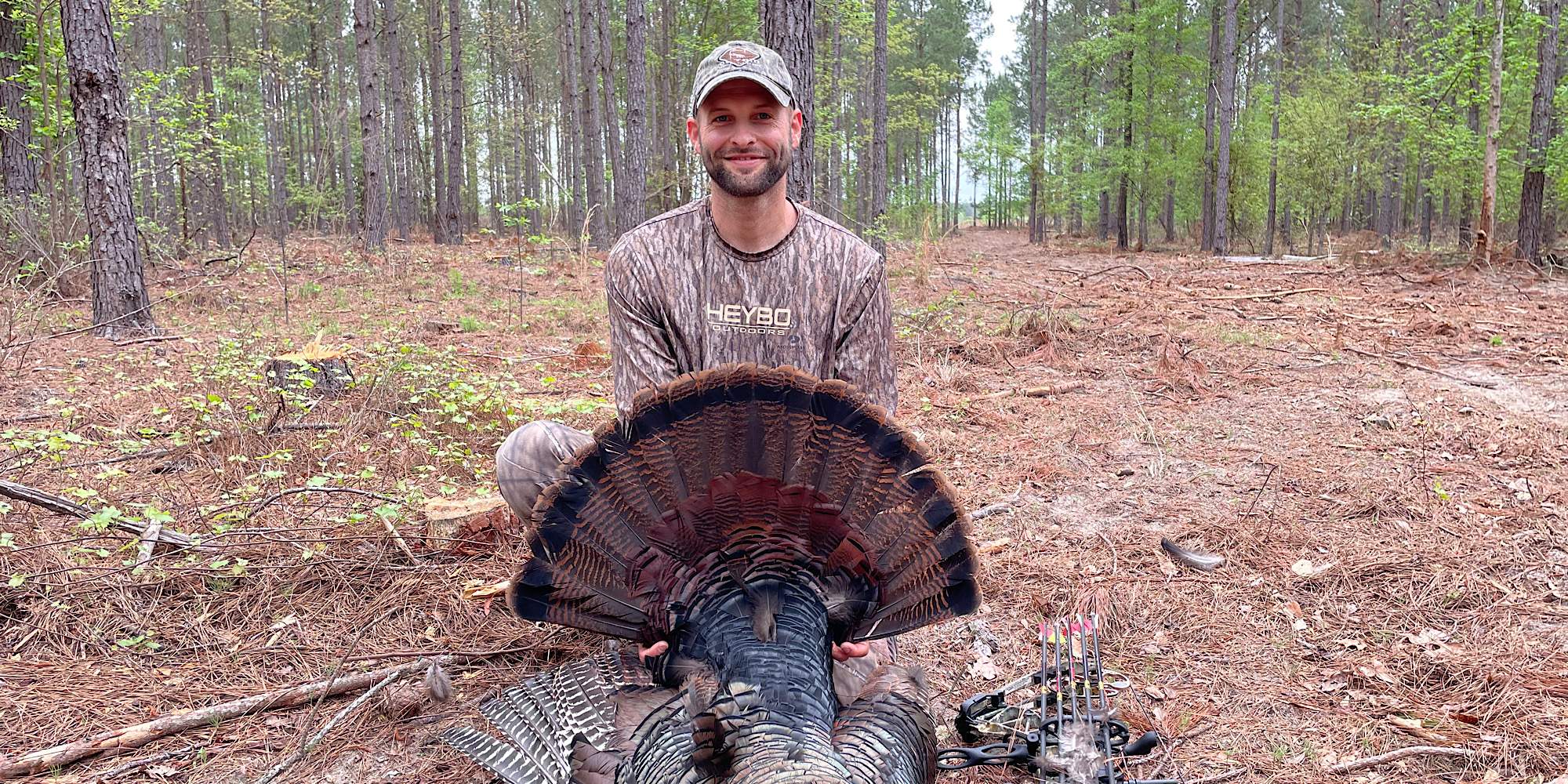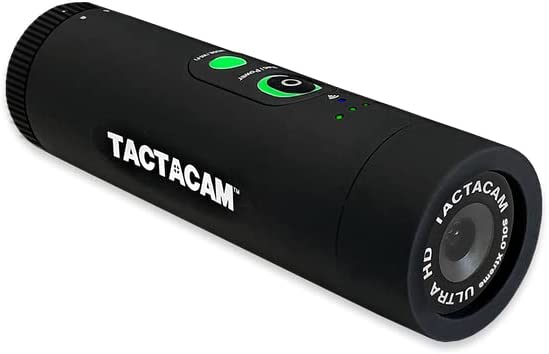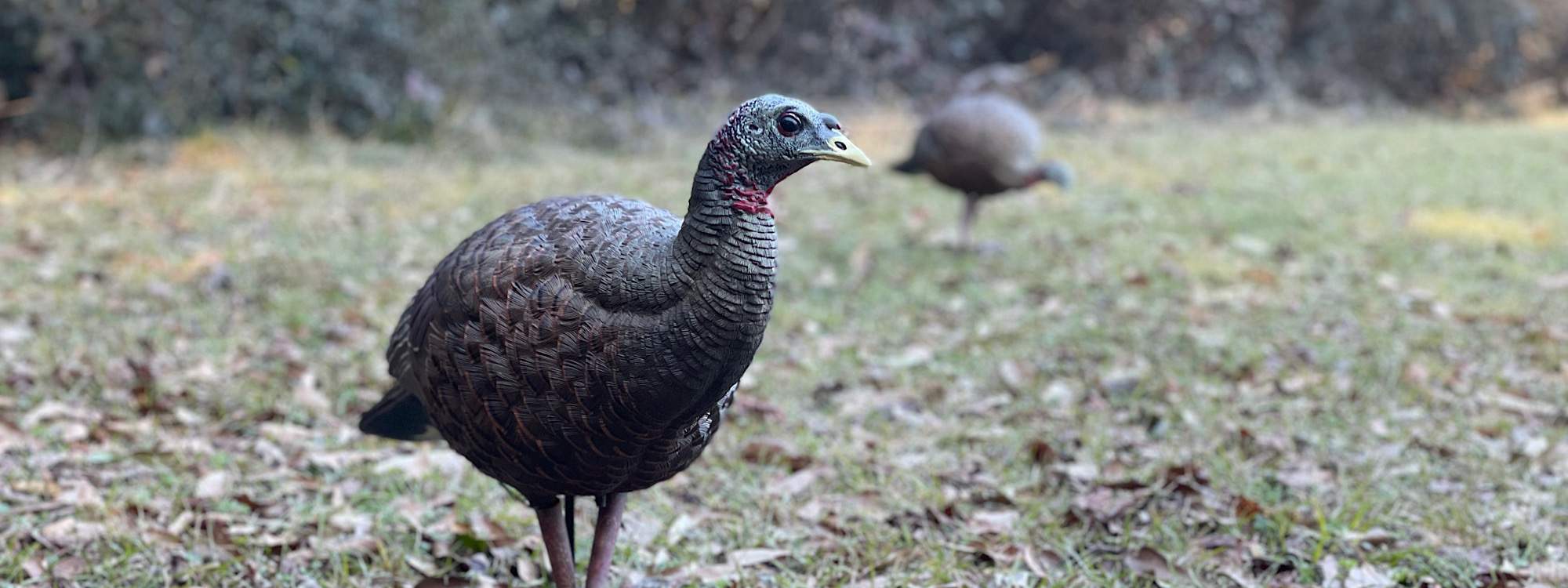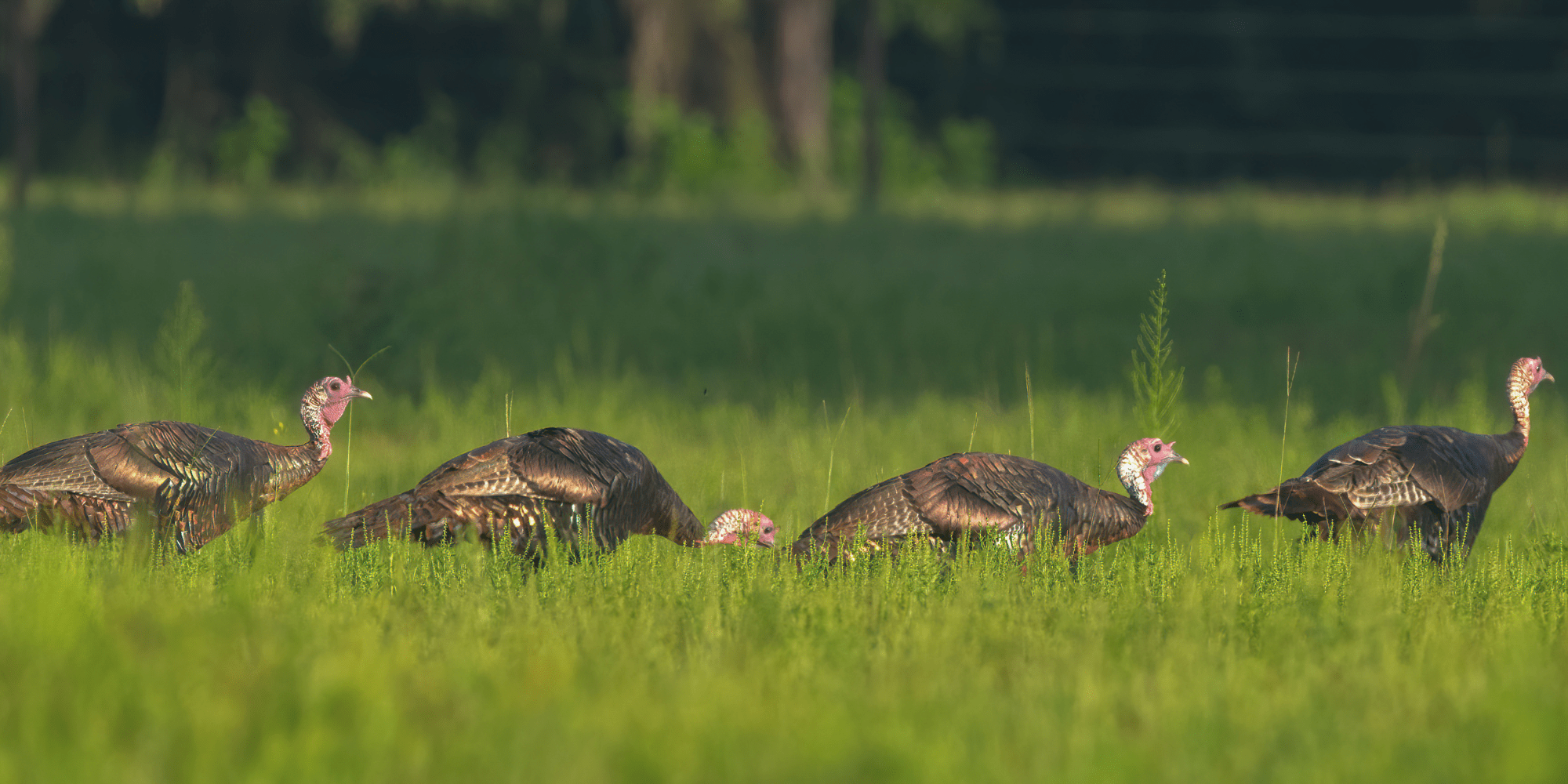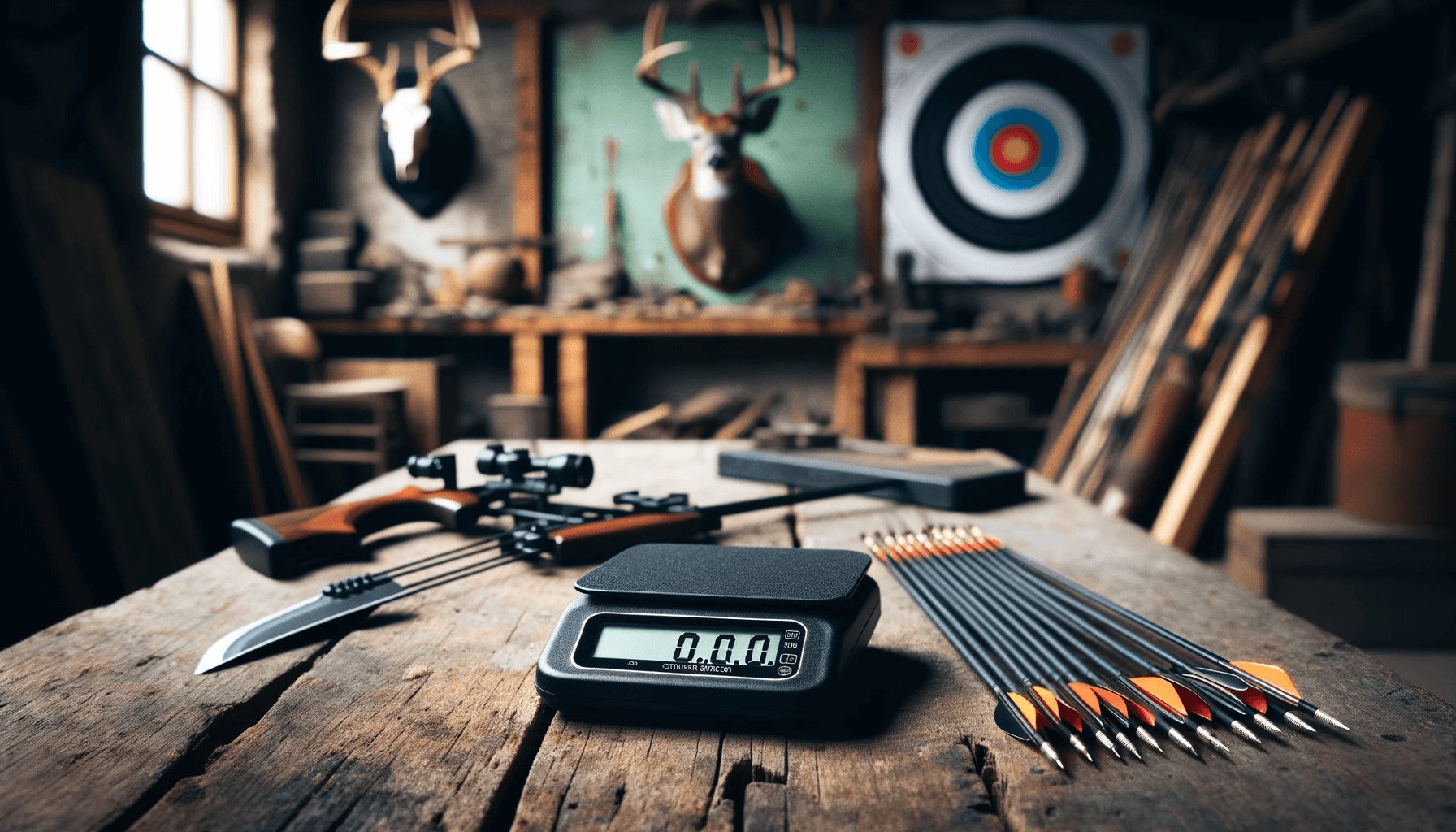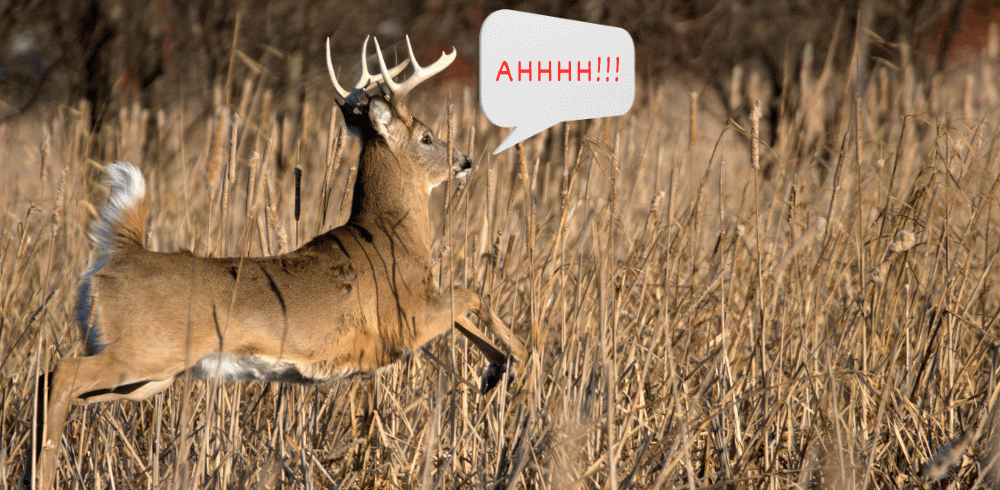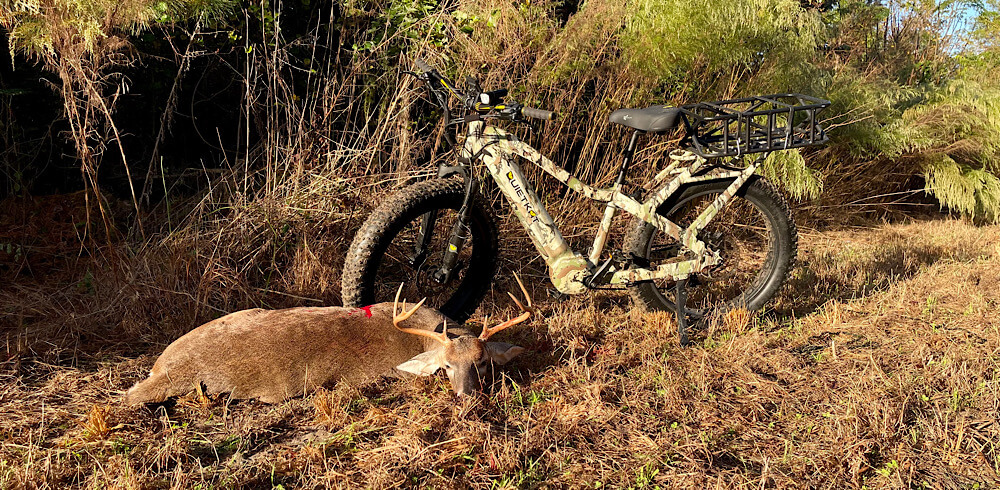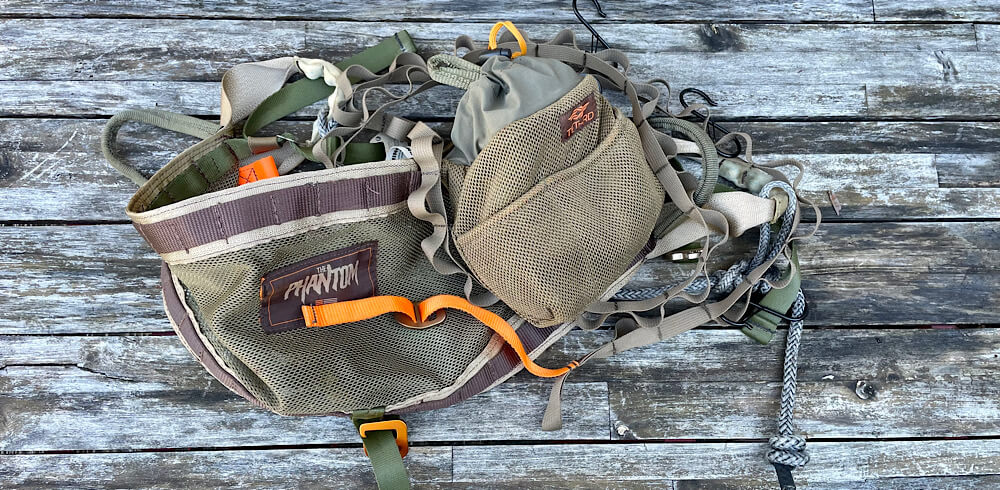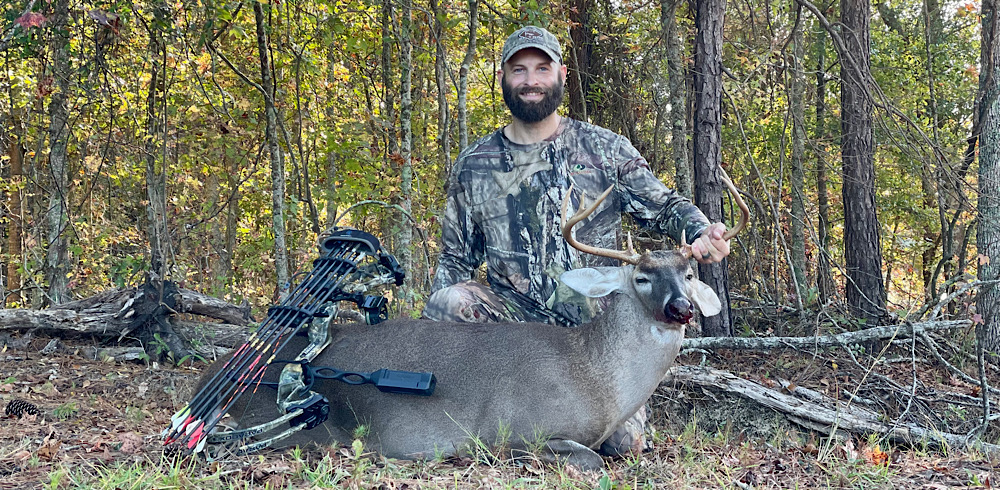How To Turkey Hunt
This is going to sound cliché and maybe a little corny, but bare with me. Learning how to turkey hunt isn’t a destination to reach. It’s a journey that will last a lifetime.
I know, I kind of cringed writing it. But it’s true. I’ve been chasing longbeards for over 15 years and I’m still learning every year. Turkeys live in the wild 24/7, 365.
They know how to stay alive, and they get better and better as they age. It should be no surprise then that it’s nearly impossible for a species as comfortable as ours to get within 40 yards of one.
It takes a lot of knowledge and experience to consistently get close. I’ll deliver the knowledge, but it’s up to you to get out and get the experience.
Wanna know how to turkey hunt? Let’s get started.
Turkey Hunting For Beginners
When you’re first starting out, scouting is going to be your best friend. If you’re not willing to get out in the woods before the season begins, you’re going to be in for a long and lonesome season.
Scouting is the best experience you’ll ever get and it is a prerequisite to a successful season. Your number one objective is to locate turkeys.
How to Scout For Turkey
If you don’t know for a fact that there are turkeys on a given property, there’s no point in hunting it, but you don’t want to waste time aimlessly traipsing through the woods hoping to stumble upon good sign.
You need a plan. If you’re familiar with a property and know the spots that are more likely to hold turkeys, that’s great.
Otherwise, you’ll want to start with e-scouting. It’s the best first step in learning how to turkey hunt efficiently.
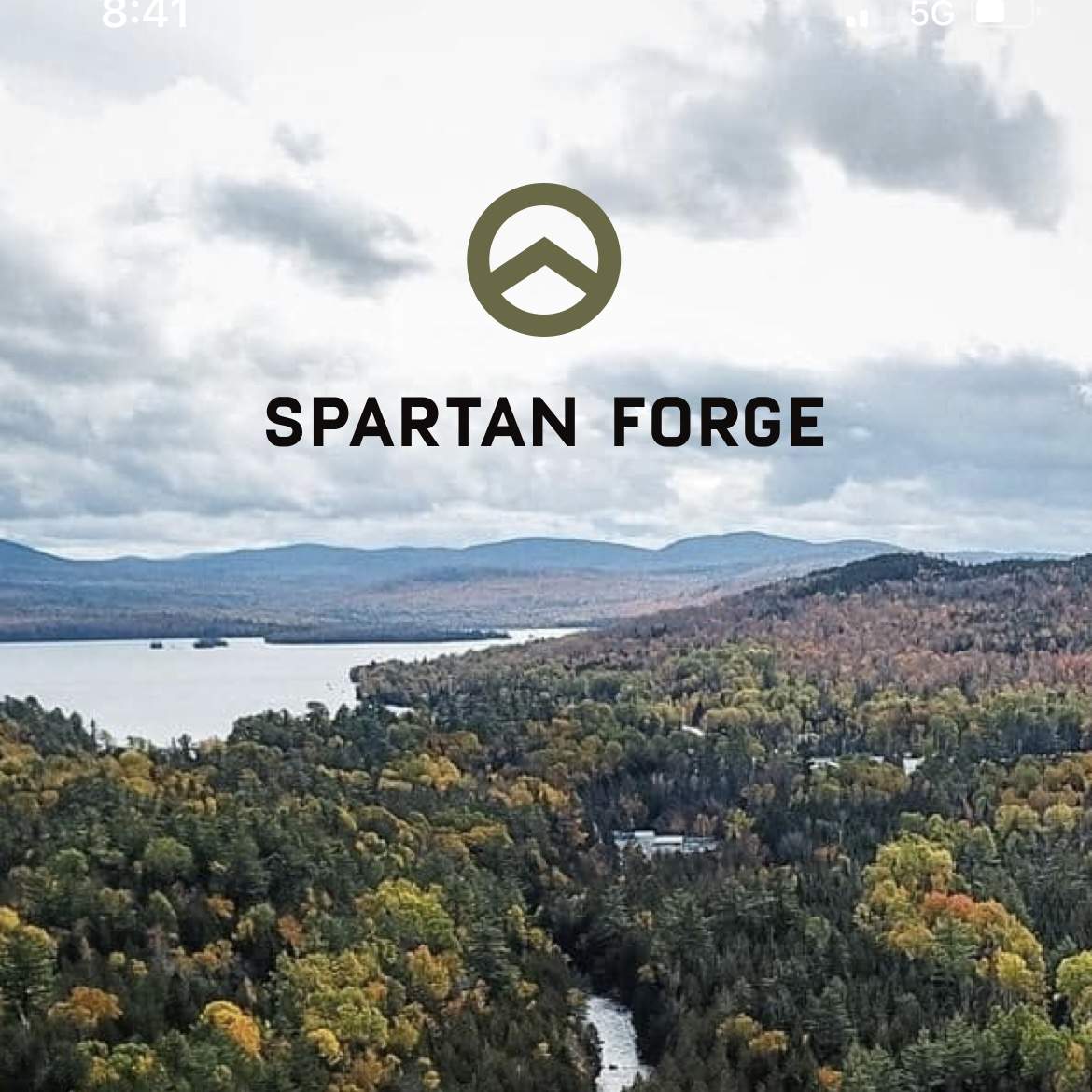
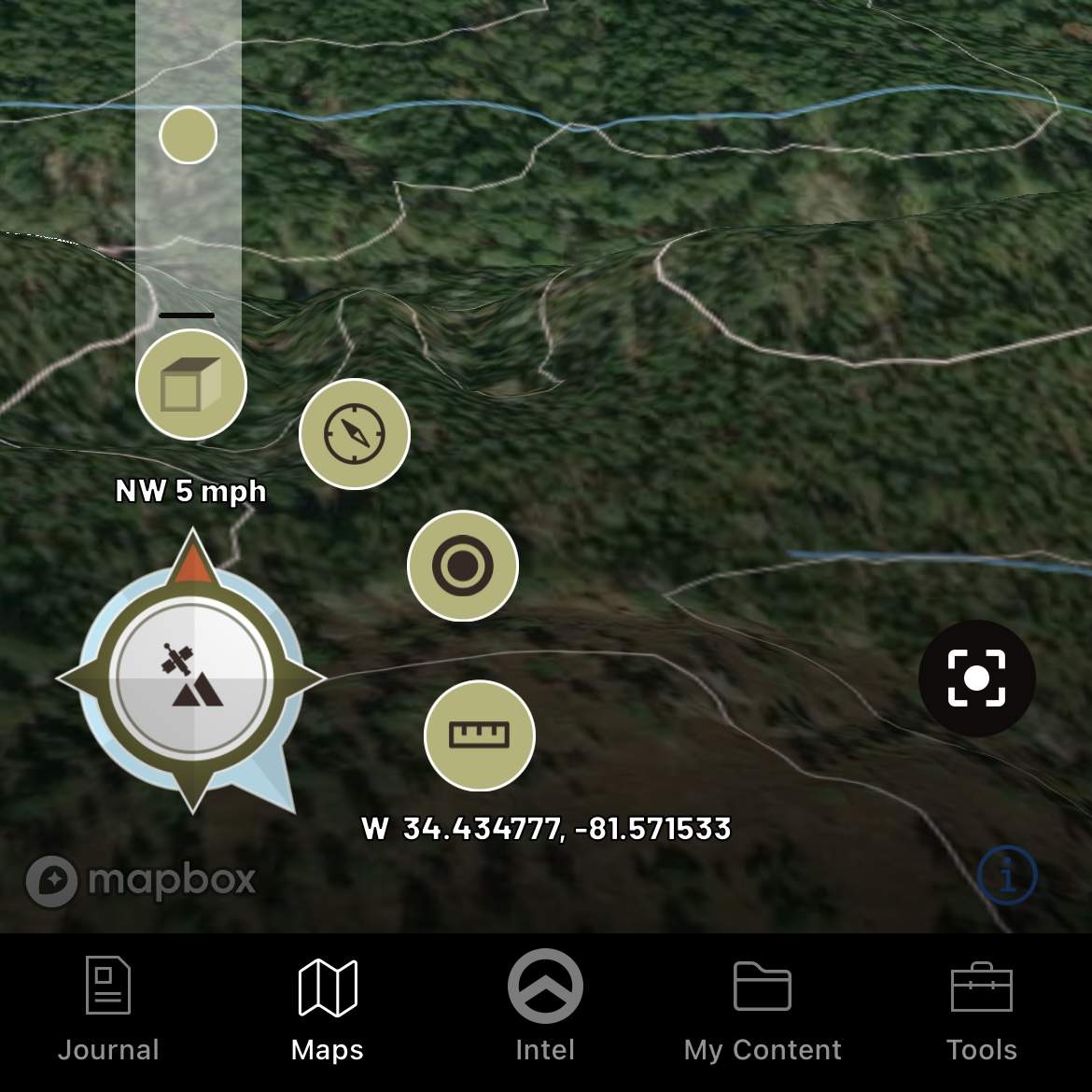
E-Scouting with Spartan Forge
If you’ve done any big game hunting for a while, you’re probably familiar with the term, but just in case, it’s basically just looking at a map on a mapping app that allows you to locate the ideal places to put boots on the ground.
Spartan Forge is the best app on the market by far. It offers so many amazing features – more than their competitors – the imagery is amazing, and there’s a free and paid version.
The free version even offers hourly, 7-day forecasts. It’s free, you need it, so let it download while you read the rest of this article.
As you pull up the property on Spartan Forge, you’ll want to look for water and open fields if there are any on the property you’re hunting.
If you’re hunting public lands and there are private fields that butt up to it, you’ll want to mark the timber behind the fields for investigation. Spartan Forge is capable of showing you public and private boundaries so you can remain on the public side.
Roost Them When Possible
A big part of figuring out how to turkey hunt is learning how to roost them.
Getting to a piece of property before daylight just to listen for gobbles is a great way to know if turkeys are there and where they are roosting.
However, hearing no gobbles absolutely does not mean there are no turkeys present, especially on pressured land.
Poor weather also contributes to turkeys not sounding off in the mornings. Late evening is another great time to locate a roost.
Using an owl hoot early morning or late evening often makes them “shock gobble,” giving away their location. Never use a turkey call to locate turkeys before the season.
It can cause turkeys to become call-shy, but it could also result in bumping turkeys who are silently coming to your call as you’re walking through the woods.
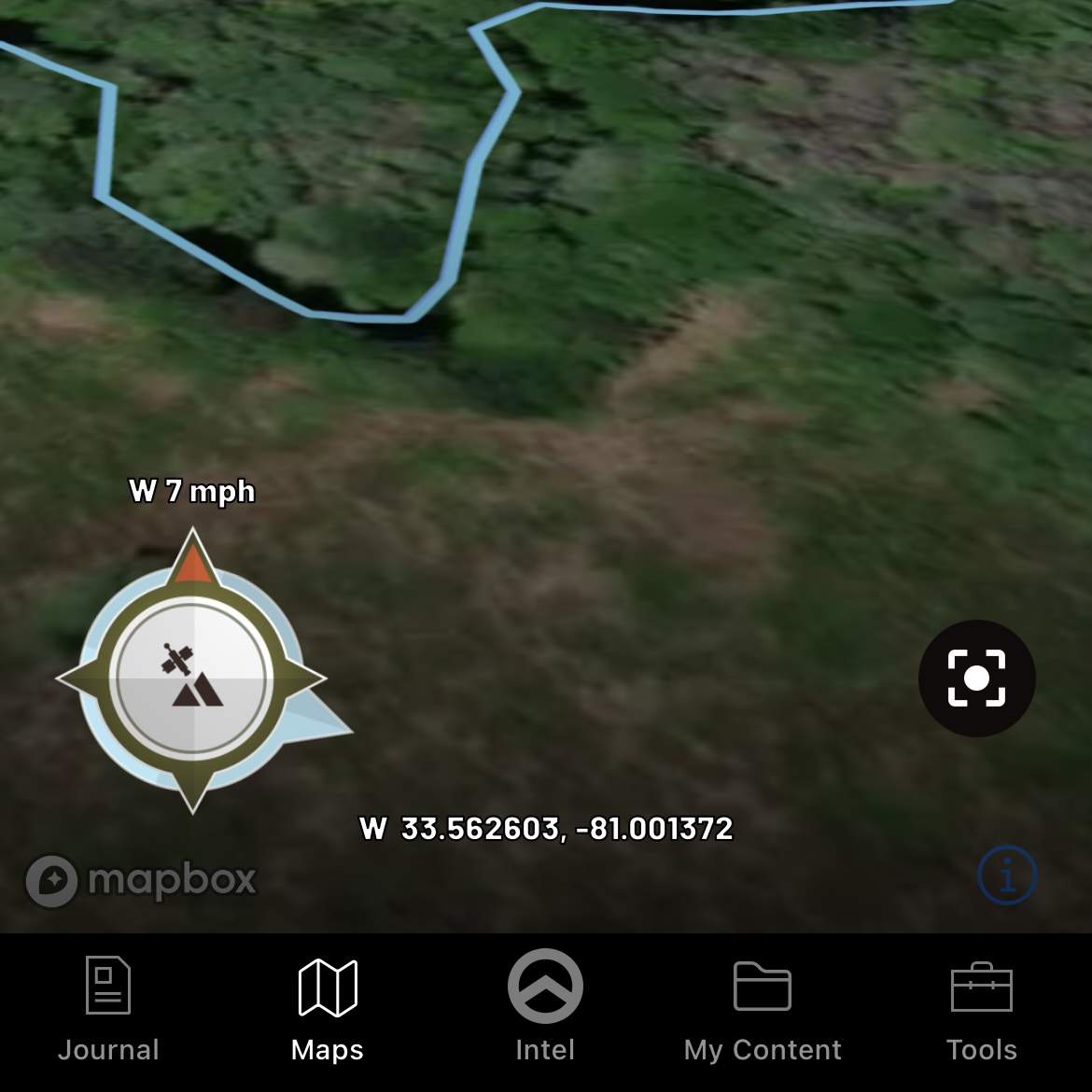
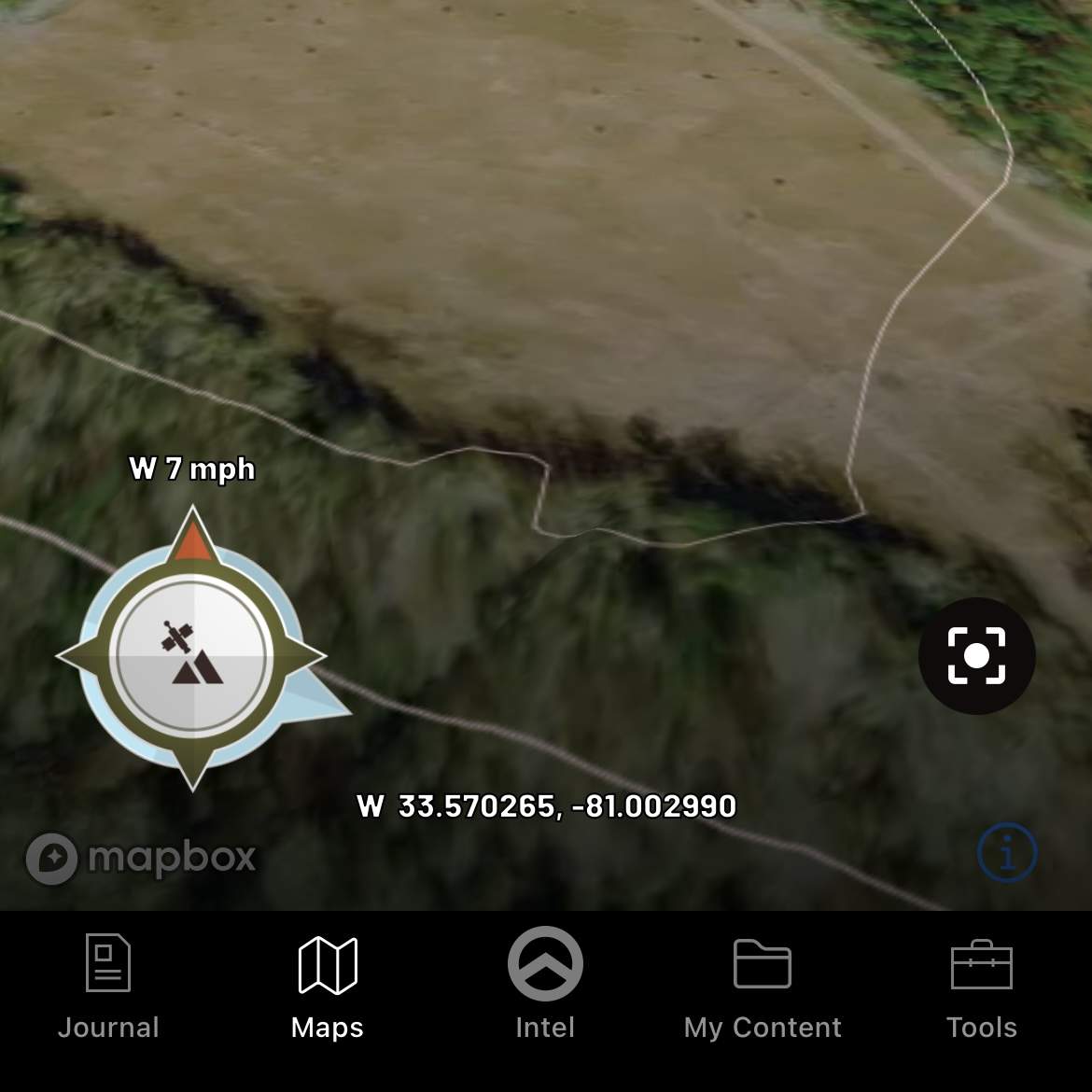
Start With Water, Fields, and Ridges
Turkeys love roosting over water. If there are both turkeys and water present on a property – a stream, creek, river, swamp – the turkeys are likely roosting over it.
They will roost in other areas, such as on ridges and field edges, but water is their favorite place to roost. It acts as a buffer against predators, but also gives them easy access to quench their thirst right before roosting for the night and just after flying down in the morning.
They’ll oftentimes pitch off the limb onto an adjacent ridge or straight into the bottom. They can often be found in creek bottoms during the heat of the day due to the lower temperatures found there.
Mark any water you see on Spartan Forge, then move on to ridges, fields, clear cuts, and any other openings that could serve as a great place for turkeys to feed and strut.
These are all the areas that you’ll want to investigate through boots-on-the-ground scouting. It’s the key to figuring out how to turkey hunt a particular property.
How to Turkey Hunt - Boots on the Ground
As you’re learning how to turkey hunt, you get better and better at recognizing the areas that turkeys prefer to be in, but only if you’re actually spending time in the woods. This is where boots-on-the-ground scouting comes in.
As I stated above, turkeys love to roost above water, on ridges, and field edges, but what about after flying down?
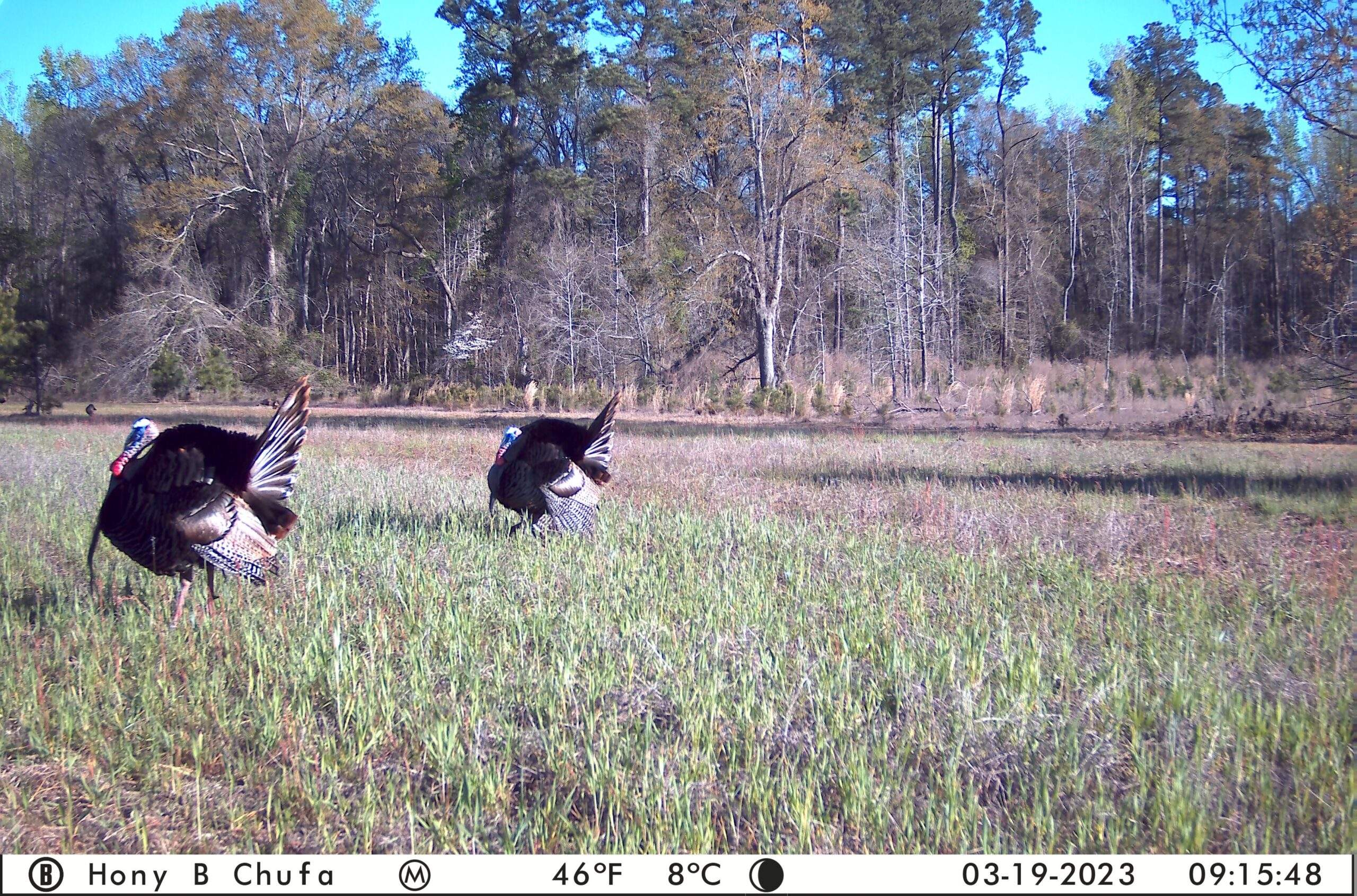
Fields and Open Areas
If there are fields on a property, there’s a good chance you’ll find them there during the first couple hours of the morning and the last couple hours of the day.
However, you won’t typically find them there during the heat of the midday sun. They typically spend the majority of their days in the shade of the timber or down in a creek or river bottom.
So, if there are fields on the property you’re scouting, that’s the first place to look. Walk the edges looking for turkey tracks, poop, feathers, and scratchings.
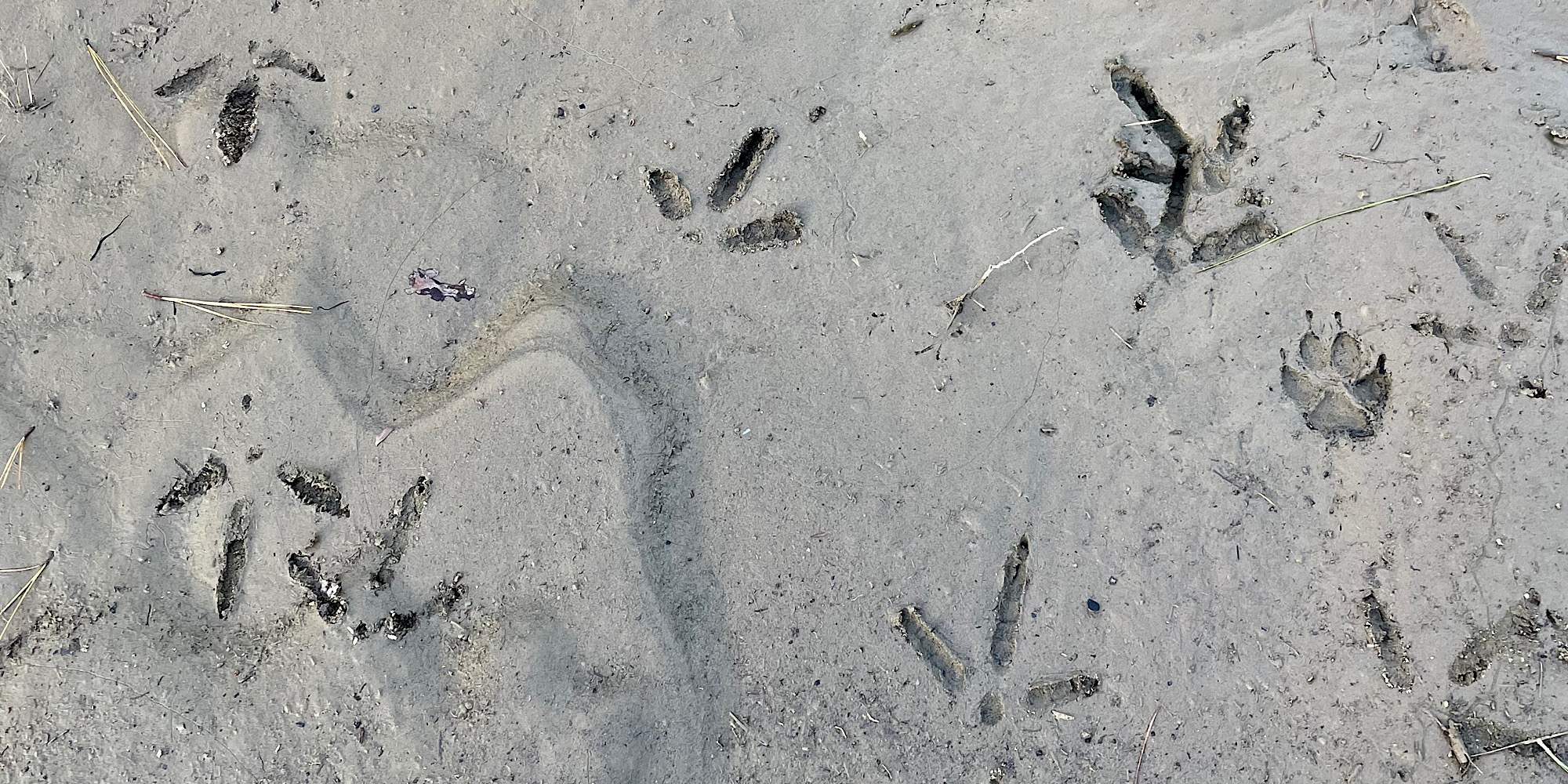
If you locate good sign, you know you’re in the money. Mark the heaviest sign on Spartan Forge and move on to the next spot.
Ridges and Bottoms
Ridges are another great location to find turkey sign. Learning how to hunt turkey in ridge country can be more challenging than in open ag fields, but ridges offer some of the best turkey hunting you’ll find anywhere.
Turkeys not only love to roost on them, but they also love to spend time feeding and strutting, where their gobbles can be heard by hens and other gobblers from hundreds of yards away.
Walk the ridges that are in close proximity to a river or creek bottom if there is one available. Oftentimes, turkeys pitch off of their limb straight over to a ridge where they’ll gobble and feed.
If you’re in ridge country where there aren’t fields or large open areas available, turkeys will often move from ridge to ridge throughout the day.
Due to daytime temperature differences between river/creek bottoms and high points, turkeys will often stay down in bottoms. Again, you’re looking for any visible sign that will indicate turkeys use the area.
Turkeys Are Routine Animals
Figuring out how to turkey hunt a property can feel a little overwhelming when you’re first starting out on it, but the beauty of turkey hunting is that you can be successful at any time of day.
You don’t have to know exactly where they’re roosting to kill them. Turkeys travel, feed, and strut all day long, and when unpressured, they typically visit the same areas on a daily basis.
Pressure does change that, so it’s important to keep pressure to a minimum on private land, and to get as far away from it as possible on public.
If you find tons of fresh sign somewhere, and there is little or no pressure in that area, those turkeys will likely be there at some point again within a day or two.
And even if they don’t typically frequent that spot on a daily basis, it’s going to be way easier to call them there because they’re already familiar with it.
Turkeys are much more apt to come to a call when it’s coming from a place they like to frequent. So, setting up over fresh sign, staying patient, and not over-calling is one of the best tactics for tagging a tom.
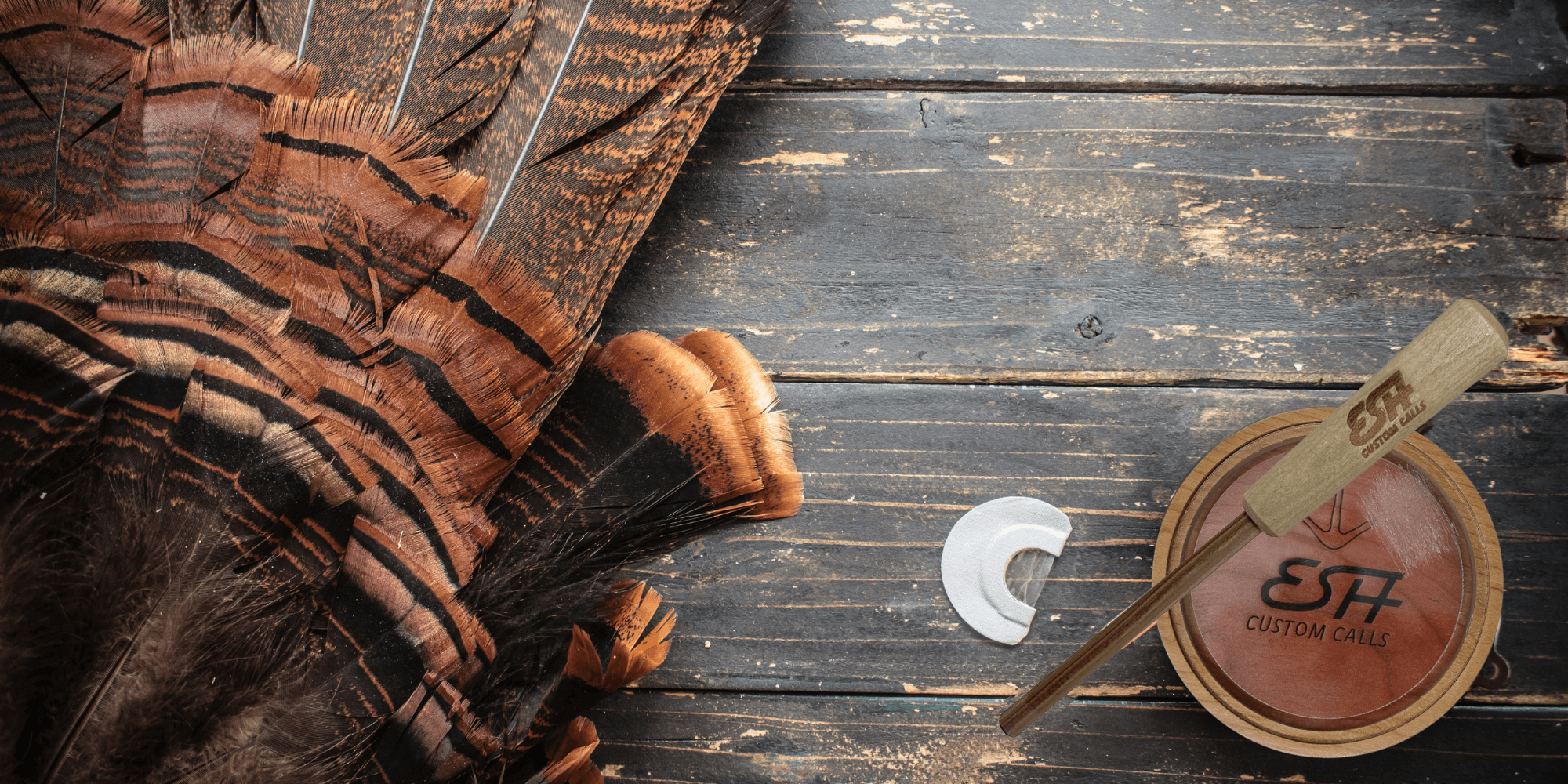
How To Turkey Hunt - Calling
Calling is the bread and butter of turkey hunting. Aside from actually locating turkeys, it’s the largest contributing factor to success.
The good news is you don’t have to sound great. You just have to sound good enough. And you’d be surprised at how bad good enough can sound.
If you’re just starting out, a box call is the easiest to use, but I’d say just jump straight to a good pot call. There’s a little more of a learning curve – much less than a mouth call – but the sound, in my opinion, is far more realistic.
There are lots of great videos on YouTube that can teach you how to use a turkey call, but I like to watch videos of live turkeys calling, so I know exactly what to emulate.
The video below is full of great examples of wild turkeys calling.
Video - Live Wild Turkey Vocalizations
How to Use a Turkey Call - Michael Waddell
Yelp, Cut, Purr, and Cluck
Yelping and cutting are going to be the two main vocalizations you’re going to want to learn first. Those two sounds have killed more turkeys than any other. Also, learning to purr is essential for when you’ve got turkeys close and hung up.
When a turkey is hung up, they may be just out of range and not getting closer. Soft purrs and clucks – natural feeding vocalizations – can bring them the rest of the way in. That has worked for me many times.
Practice Soft Calling
It’s easy to call loud and hard. And when trying to reach out and grab a longbeard’s attention from a distance, hard, loud cutting and yelping often does the trick.
But that same tactic to a turkey is relatively close will oftentimes send him in the other direction. Turkeys know how loud turkeys are at different distances.
It’s crucial to call softly more often than not, especially when you’ve gotten a turkey to respond or if he’s close by. To call well softly, it takes practice.
So, practice all of your vocalizations softly. You can always raise the volume in the field, but you’ll be better prepared to bring them in softly when it’s called for.
Less is More
I’d venture to say that the number one cause of missed opportunities in the turkey woods is calling too much. A lot of newer turkey hunters are so fired up to get a bird to respond that they call way too often and way too loudly.
My rule of thumb is to never call to them in the tree, start calling after I know they’ve flown down, and to call every 15-30 minutes on unpressured land and less than that on public land.
Turkeys don’t just walk around calling all day long. After the first couple hours of the day, turkeys are usually pretty quiet, so persistent calling sounds unnatural and can result in call-shy turkeys that are extremely hard to kill.
You can never call too little, but you can always call too much. So, call infrequently, and when you get a gobbler to respond, don’t call again unless you can tell he’s not coming after about 10-15 minutes.
When I get a gobbler to respond, I don’t call again. If he gobbles again from the same location 10 or 15 minutes later, I call again a couple times in succession and wait more.
If he does break my way, I just let curiosity and natural instincts do the rest of the work. If he hangs up close by, that’s when extremely light purring and clucking can bring him the rest of the way.

Silence Doesn't Mean He Isn't Coming
If you don’t get a response from your calling, don’t think for a second it means there is no turkey around or that one isn’t coming, especially midday.
Turkeys are most vocal early morning, but turkeys will oftentimes silently come to your call. They’ll just all-of-a-sudden appear right out in front of you.
If you’re not careful and you let your guard down, you could get caught moving or calling too much by a wary longbeard that silently crept in to investigate.
Trust me – I’ve done it, and it was a horrible feeling. Other times, they may not respond until they’ve come in to around 75 yards.
You just never know, so never count yourself out.
Setup is Key
So, you’ve located turkeys. You believe you’ve figured out where you need to set up, but do you just sit up against the closest tree?
There’s a lot more thought that needs to go into it than that. Setup is another one of the most important pieces of the puzzle when learning how to turkey hunt effectively.
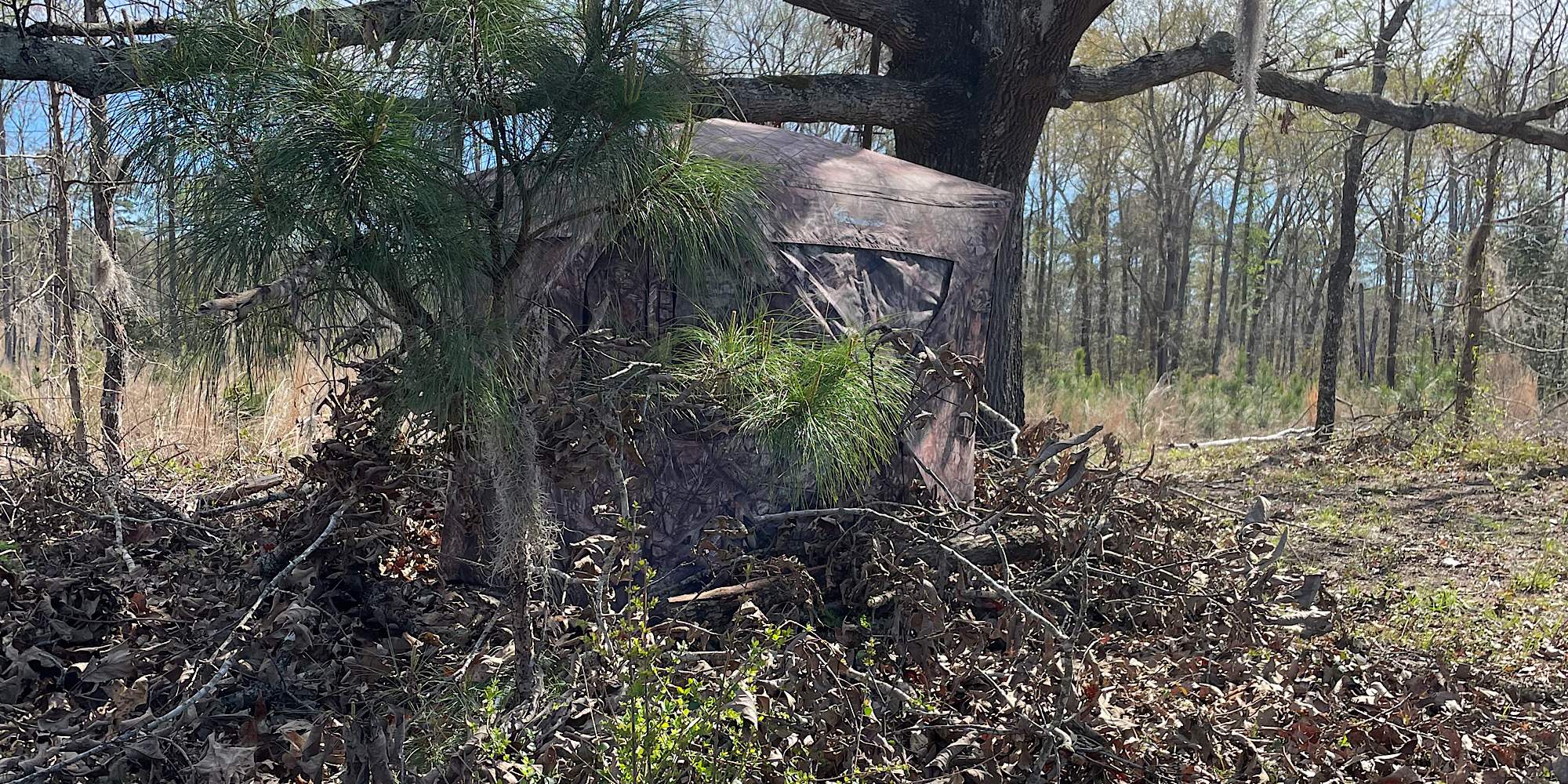
How to Turkey Hunt With or Without a Blind
Start out by deciding if you’re going to sit in a blind or not. Blinds are great because they offer a lot more concealment than just setting up on the ground, but they do limit your ability to move if necessary.
For bowhunters, you can’t beat them, but you need to make sure you’re in one that offers plenty enough room at full draw. The Ameristep Brickhouse blind is a great blind that fits multiple people, a lot of gear, and still has a lot of room to go full draw without being seen.
And it has a lot of windows to shoot from. Just make sure you don’t open too many. The more you open, the more light you let in.
Unlike deer, turkeys will sometimes walk right in front of a well-placed blind the same day it was set up, but it’s best to set it up in advance so wary turkeys can get used to it.
After all, you’re wanting them to ideally get within 20 or 30 yards. Brushing them in with natural vegetation will create a more natural, 3D look and will serve you much better than simply popping one up in the open.
If you opt for hunting with no blind, you just need to know that a turkey’s vision is 3x greater than that of a human who has 20/20 vision. And with a 270-degree field-of-view, it’s easy to get picked off before you even know he’s there.
So, making sure you’re well-hidden behind brush, wearing camo that blends in with your surroundings, and moving as little as possible is critical to success.
Make sure to choose trees that are wider than your shoulders to hide your outline. And a leafy suit, gloves, and head net or face paint should be worn at all times.
Set Up in the Shade
Whether in a blind or not, make sure the sun isn’t shining directly on you. The sun will exaggerate your movements, which are inevitable as you reposition to take a shot.
Also, any sheen from a blind or sweat-wicking camo will shine in the light. Stainless steel broadheads will do the same.
Choose the Right Distance
If you’re gun hunting, you have more leeway with distance. Setting up 20+ yards from where you expect them to be gives you more room concealment, but bowhunters need to be closer.
Longbeards have a tendency to hang up. If a turkey hangs up at 40 yards for a shotgun hunter, he can still easily make the shot.
Most bowhunters aren’t comfortable making that kind of shot on a target that small. So, I usually set up around 12 yards from where I expect them to be with my bow.

Using Decoys
Decoys can be your best friend or your worst enemy. As a bowhunter, I love using them because I need the turkey to be close to make an ethical shot. And it also serves as a great distraction while drawing.
You’ll have some of the best hunting of your life when a seldom-decoyed turkey comes into a decoy setup, but turkeys that have been decoyed a lot will oftentimes just stare from a distance, and ultimately leave.
If you’re hunting private land or deep in a secluded area of public, I say put them out. I’ve had great success with a jake and laydown hen, two hens, a laydown and a feeder hen, a single lookout hen – the point is there’s no formula to how many or which kinds of decoys will work best.
You just need to make it realistic and use realistic looking decoys. Avian-X are the most realistic decoys I’ve seen and I’ve had so much success with them over the last three years. I highly recommend them over any other.
I’ve seen them in action and their results speak for themselves.
Where to Shoot a Turkey
Like with all animals, shot placement is critical, especially with archery gear. The good thing about turkey hunting is that shots often occur at relatively short distances.
Shot Placement With a Shotgun
With a shotgun, you want to aim just below the head. Some people aim straight at the head, and that works, but if you accidentally jerk the trigger and shoot high, you can miss completely or injure the turkey.
Aiming a little under the head insures that if you miss a little high or a little low that the bulk of your shot hits the neck or head.
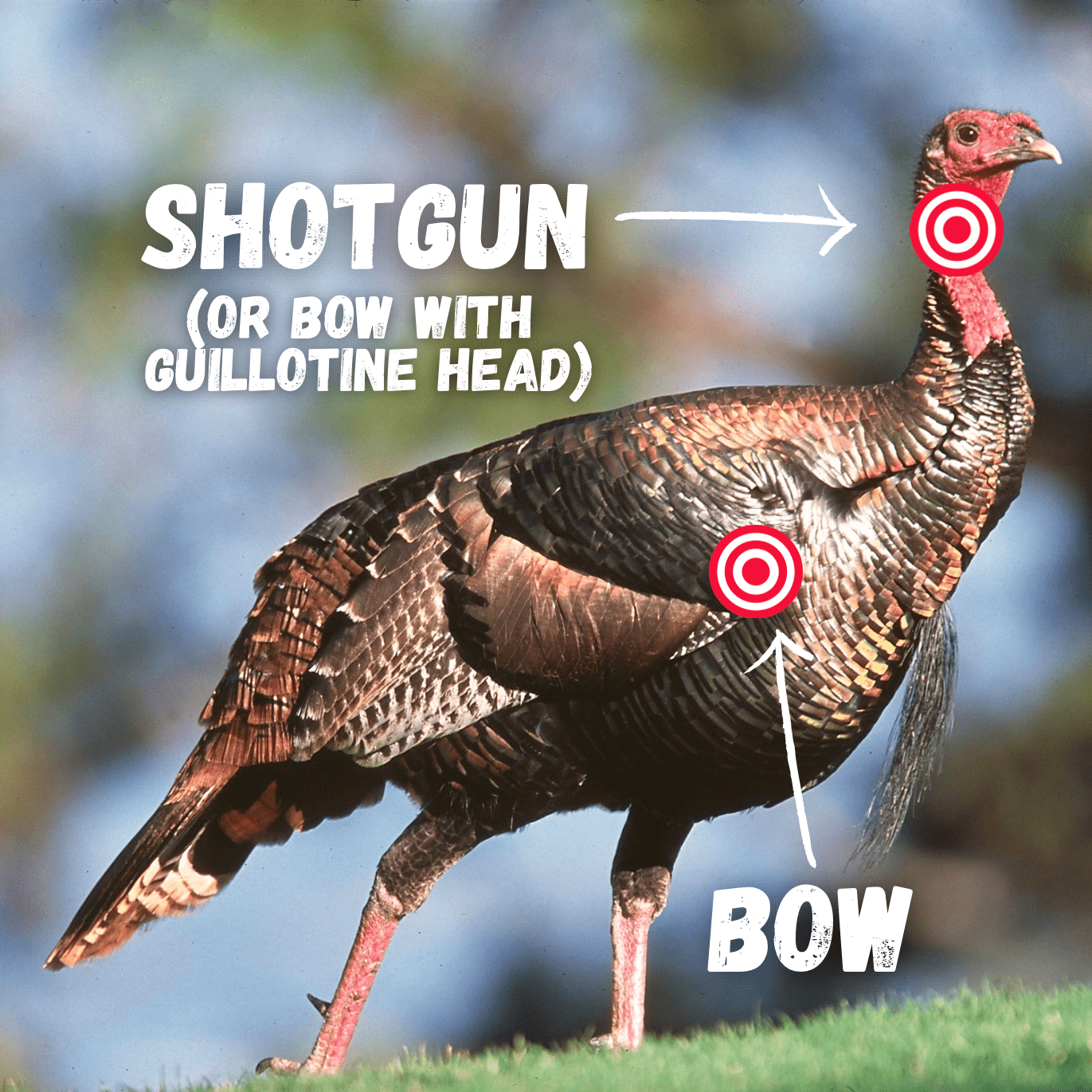
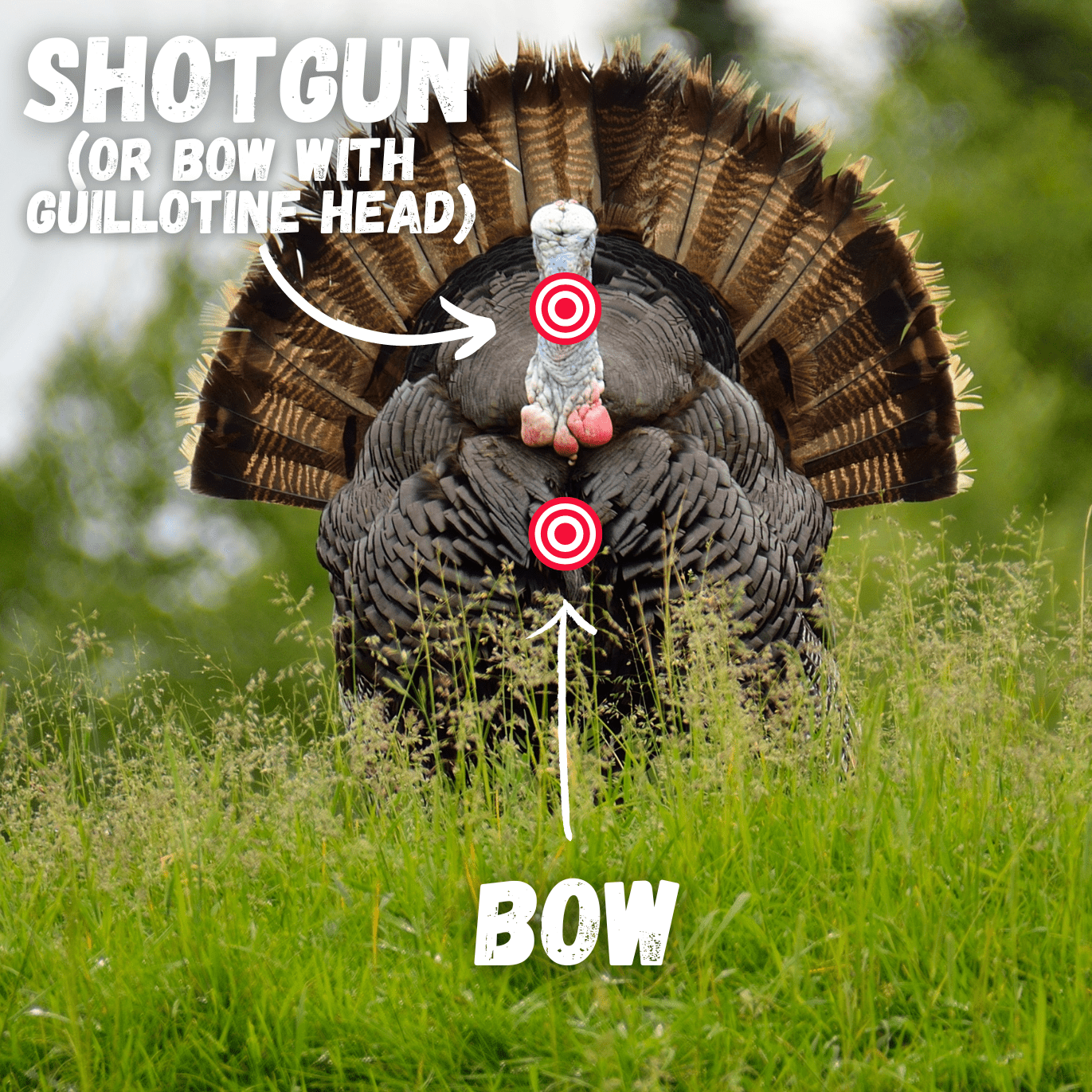
Where to Shoot a Turkey With a Bow
When you’re deciding where to shoot a turkey with a bow, you have several options within two larger options.
The two larger options are straight at the head/neck, which requires a large-cutting, guillotine-style broadhead, or in the vitals.
Aiming at the head/neck is straightforward. Aiming at the vitals opens you up to several options. First, if you have a turkey full strut facing you, you’ll aim straight on, just above the beard.
If he’s broadside, you’ll want to aim about midway up the body and right where the wing meets the body.
Finally, if he’s full strut facing straight away, you aim right for his vent, otherwise known as his b-hole. Yep, you read that right.
I prefer broadside shots. Shot placement on a non-strutting turkey is a little easier to find because you can easily see the outline of his body.
However, full-strut toms are trickier because the outline of the feathers can be deceiving. Shooting a 3D turkey target has helped me greatly with learning shot placement, so I don’t really have to think about it when I decide to draw back.
I highly recommend archery practice with 3D targets of whatever animal you’re hunting.

Patience Kills Turkeys
In the age of YouTube and social media, it can be easy to think that all you have to do is walk through the woods calling, and you’ll strike up a lonesome longbeard that will later be riding in the bed of your truck.
It usually doesn’t work out that way. Most of the personalities that you see on YouTube that are consistently successful are hunting 10-20 times more than the average hunter.
So, they’re going to find success that way some times. For the average hunter, scouting and generating a good plan, followed by loads of patience and perseverance are usually what not only brings success, but wisdom and woodsmanship.
The more patient you are, the less you’ll pressure birds and the more you’ll learn through sightings and tagged birds.
Learn from the mistakes and missed opportunities, and know that learning how to turkey hunt is a lifelong process.
Scout more than you hunt, think through your setups, be patient, learn more with every hunt, and you’ll tag more longbeards in 10 years than most turkey hunters will in a lifetime.
Have More Questions?
I’d love to chat. Leave a comment below or reach out on my contact page or through Instagram or Facebook @southeasternbowhunting.

